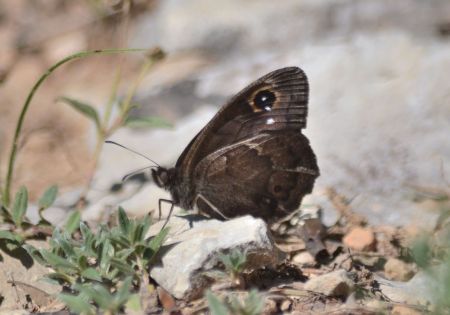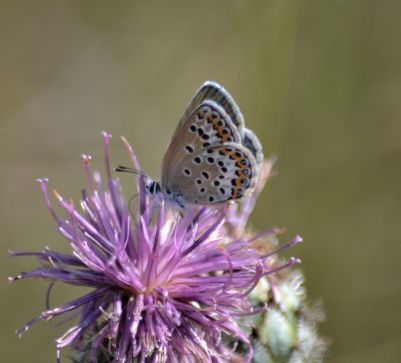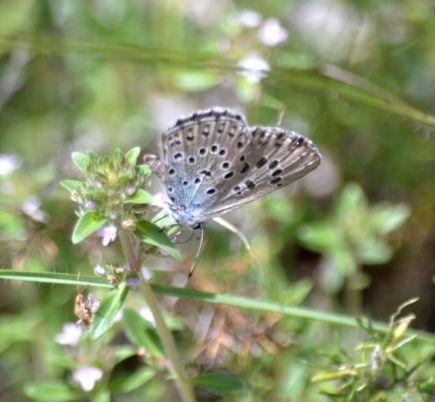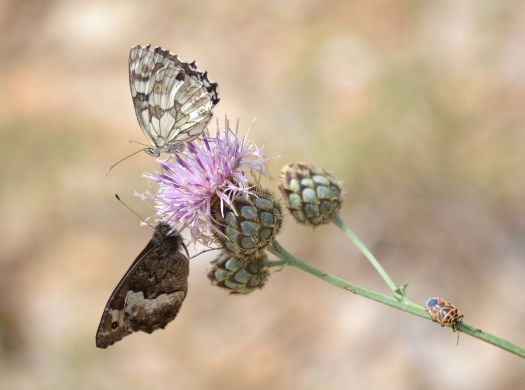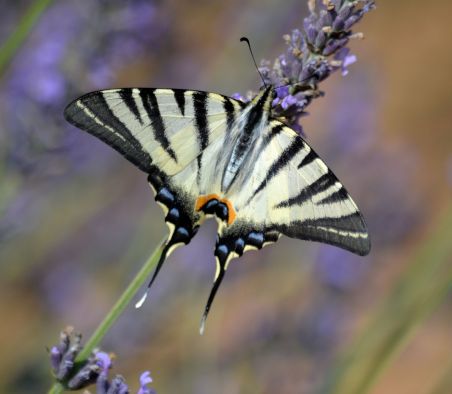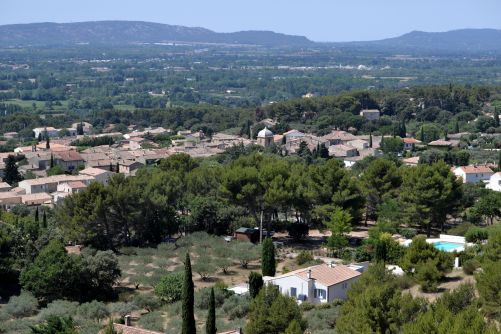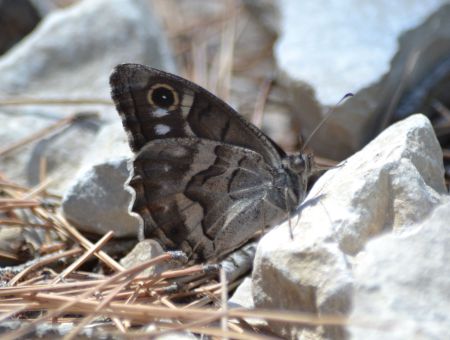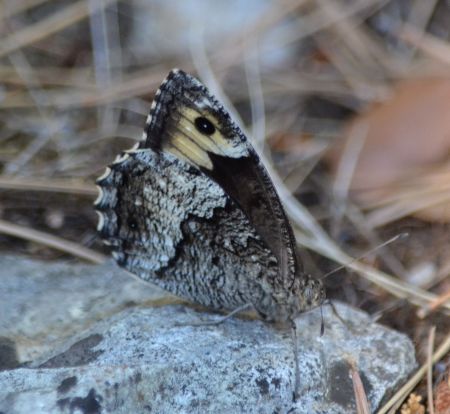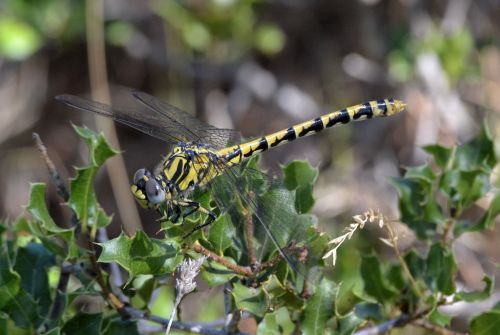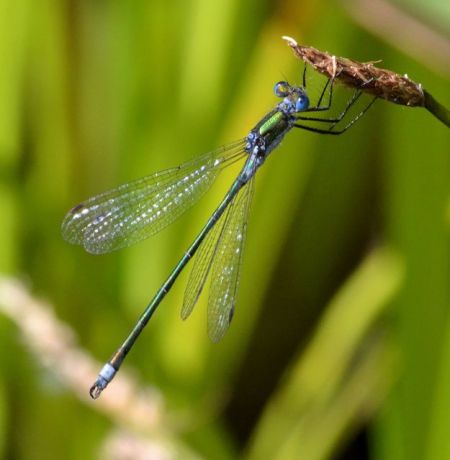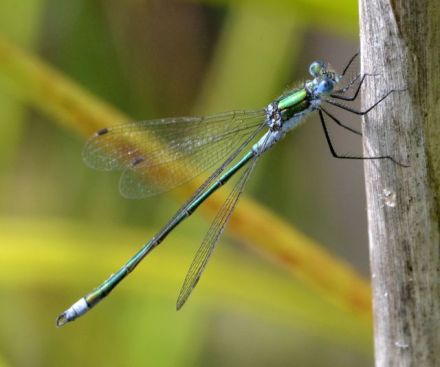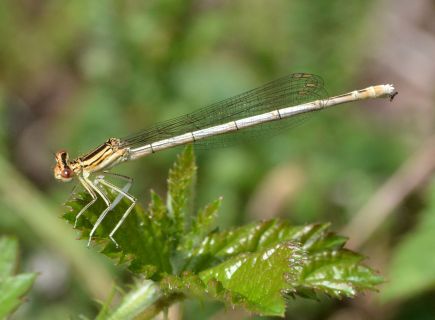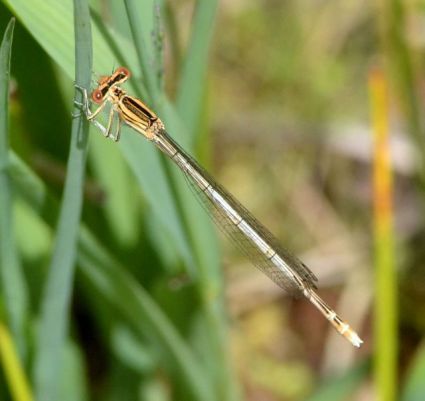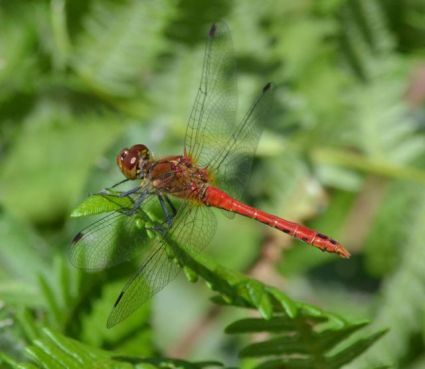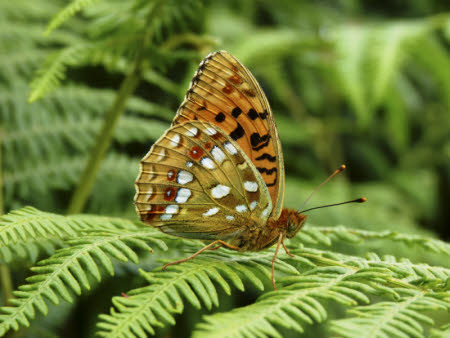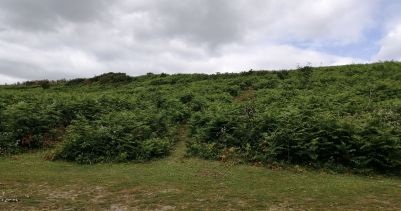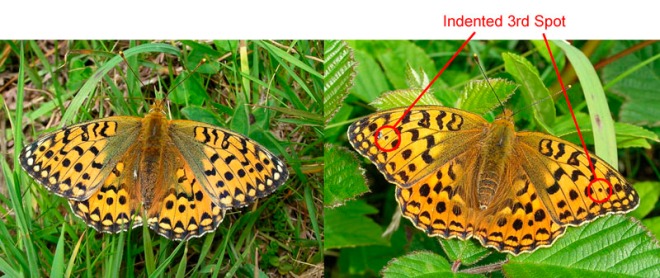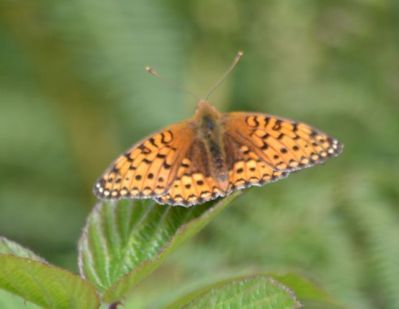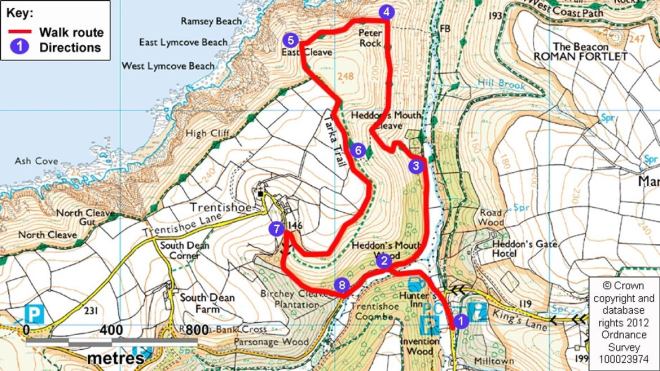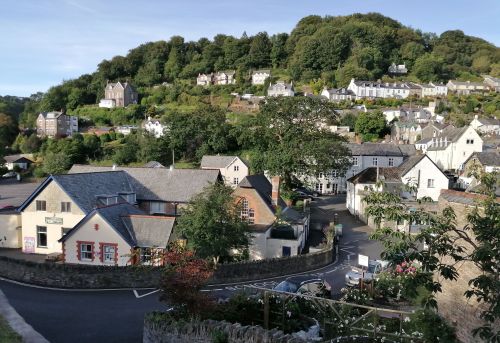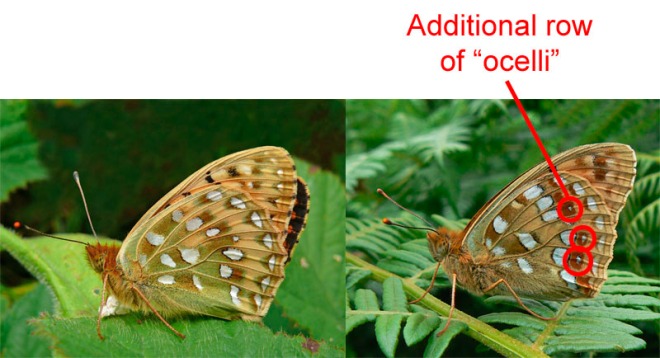On my final day in Provence I set out to explore one of the highest peaks to the north of my base, Montagne de Lure (1826 m) in search of the magnificent Apollo, staying there all day. Taking a winding road due north from St-Étienne-les-Orgues this climbed up and up until I reached the (presumably former ski) Station de Lure fairly near the summit. There all along one side of a large car park were clumps of Thistles that were teeming with Fritillaries and other butterflies.
Mon jour final dans Provence j’ai commencé à explorer un des plus hauts pics au nord de ma base, Montagne de Lure (1826 m) à la recherche d’Apollon magnifique, en restant là tout le jour. En prenant un nord dû routier sinueux de St. Étienne les Orgues cela grimpé et jusqu’à je suis arrivé le (le vraisemblablement ancien ski) Station de Lure assez près du sommet. Là tout le long d’un côté d’un grand parc de stationnement étaient des bouquets de Chardons qui regorgeaient de Fritillaries et d’autres papillons.
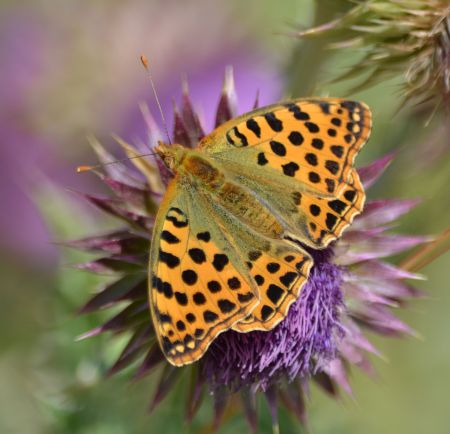
Her Majesty the Queen of Spain
The first things I beheld here on getting out of my vehicle were several High Brown Fritillary. After the excellent sightings of the previous afternoon this really was the icing on the cake, as I recalled the frustration of seeing that butterfly for the first time so poorly in Devon 10 days earlier (see here) and exulted in this much better experience. It now quite simply was how things should be. The top-side pictures I took (below) all showed the three diagnostics for the species very clearly: the indented third upf wing spot, the slightly concave outer edge to that wing and ridged black veins or “sex brands” nearer to its inside edge. The under-side study is of a rather faded individual, but also leaves no doubt as to this ID.
Les premières choses que j’ai vues ici lors du fait de sortir mon véhicule étaient plusieurs Moyen Nacré. Après les vues excellentes de l’après-midi précédent c’était vraiment le glaçage sur le gâteau, puisque je me suis souvenu de la frustration de vue que le papillon pour la première fois si pauvrement dans Devon 10 jours plus tôt (voir ici) et a exulté dans cette beaucoup meilleure expérience. C’était maintenant tout simplement comment les choses devraient être. Les dessins de haut niveau que j’ai pris (au-dessous) de tous ont montré trois diagnostics pour les espèces très clairement : le tiers en alinéa upf la tache d’aile, le bord extérieur légèrement concave à cette aile et veines noires striées ou sexe marque plus près à son bord intérieur. L’étude de dessous a d’un individu assez fané, mais ne laisse aucun doute aussi quant à cette piéce d’identité.
There were a number of other Fritillaries also nectaring on the Thistles at this site. Niobe Fritillary is quite similar to High Brown but slightly smaller and also slimmer in profile. I believe the left hand picture below is one, based on matching it to those of my only previous record in Greece a year ago. To me the butterfly appeared cleaner and paler than the richly toned High Brown, and the “sex brands” are fainter. This species displays some variation in form across its wide European range (see here).
Il y avait un certain nombre d’autres Fritillaries aussi nectaring sur les Chardons sur ce site. Chiffre est tout à fait semblable à Moyen Nacré, mais légèrement plus petit et aussi plus mince dans le profil. Je crois que le dessin de main gauche est ci-dessous un, basé sur l’appariement à cela à ceux de mon seul record précédent en Grèce il y a une année. À moi le papillon a semblé plus propre et plus pâle que Moyet Nacré richement tonifié et les marques sexe sont plus légères. Cette espèce affiche un peu de variation dans la forme à travers sa large gamme européenne (voir ici).
I am as confident of the right hand picture (above) being Marbled Fritillary, which looks cleaner and paler still though the image is not good. This was the 11th trip lifer, a quite common and widespread species in southern France that also ranges across much of south and central Europe from late May to early August. In separating such similar Fritillaries I find the markings along the upf top edge that resemble numbers to be a reliable indicator.
Je suis aussi confiant du dessin de main droite (au-dessus) de être Nacré de la Ronce, qui semble plus propre et plus pâle toujours bien que l’image ne soit pas bonne. C’était le 11ème voyage “lifer” (nouveaux papillon pour moi), une espèce tout à fait commune et répandue dans la France du sud qui varie aussi à travers la plupart de l’Europe centrale et sud de la fin de mai au début d’août. Dans la séparation d’un tel Fritillaries semblable je trouve les marquages le long du bord supérieur upf qui ressemblent aux nombres pour être un indicateur fiable.
No such detailed scrutiny was necessary for Queen of Spain Fritillary (pictured above), whose squared off profile and top and under-side markings are all unmistakable. I had not previously gained acceptable top-side images of this multi-brooded, pan-European butterfly, but that was now put right to very good effect.
Aucun tel examen détaillé n’était nécessaire pour le Petit Nacré (représenté au-dessus), dont a équarri le profil et le haut et les marquages de dessous sont tous indubitables. Je n’avais pas gagné auparavant les images de haut niveau acceptables de cet ont multibroyé du noir, le papillon pan-européen, mais cela a été maintenant mis le droit du très bon effet.
Cardinal and Silver-washed Fritillary (above left) completed the medley for the genus here, though the former proved as difficult to get pictures of as is usual for me. And no southern European trip report in the mass migration year of 2019 would be complete without a Painted Lady (right). Another man taking pictures by the car park had been told that Apollo come to the Thistles, but none did so on this occasion and so I drove on towards the summit.
Le Cardinal et Tabac d’Espagne (au-dessus du gauche) ont accompli le mélange pour le genre ici, bien que celui-là se soit aussi avéré difficile à recevoir des dessins de qu’est ordinaire pour moi. Et aucun rapport de voyage européen du sud dans l’année de migration de masse de 2019 ne serait complet sans Belle-Dame (le droit). On avait dit à un autre homme prenant des photos par le parc de stationnement qu’Apollon vient aux Chardons, mais personne n’a fait ainsi dans cette occasion et donc j’ai conduit sur vers le sommet.
My next stop was by an Alpine meadow where I came across good numbers of another lifer, False Heath Fritillary (pictured below) as I had expected to do here today. That meant I had now self-found all of the Fritillaries recorded by the 2014 Greenwings group, which was quite satisfying. FHF is most usually found at altitude and exhibits a lot of variation in both tone and size. I kept on encountering this butterfly for the rest of the day, and some were very small indeed while others appeared almost black in flight.
Mon arrêt suivant était par une prairie Alpestre où j’ai trouvé de bons nombres par hasard d’un autre “lifer”, Mélitée noirâtre (représenté si-dessus) puisque je m’étais attendu faire ici aujourd’hui. Cela a signifié que j’avais trouvé de soi maintenant tous les Fritillarie enregistrés par le groupe de Greenwings de 2014, qui était satisfaisant tout à fait. FHF est le plus d’habitude trouvé à l’altitude et expose beaucoup de variation tant dans le ton que dans la grandeur. J’ai continué de rencontrer ce papillon pour le reste du jour et certains étaient très petits effectivement pendant que d’autres ont semblé presque noirs dans le vol.
At this site I watched the day’s first of two Apollo in flight that stood out by it’s size, speed and graceful jizz. Another rather striking item was female Large Wall Brown (pictured above) of which I came across a few at this altitude. I had previously seen only worn males of this pan-European inhabitant of steep rocky places, so this encounter here was rather more attractive. This species flies from mid-June to late August in the south of its range. Various Clouded Yellow (below) were also active from this stage onward.
Sur ce site j’ai regardé le jour d’abord de deux Apollo dans le vol qui est ressorti par cela est la grandeur, la vitesse et jizz gracieux. Un autre article assez frappant était le femelle Ariane (représenté au-dessus) dont j’ai trouvé quelques-uns par hasard à cette altitude. J’avais vu auparavant mâles seulement portés de cet habitant pan-européen d’endroits rocheux raides, donc cette rencontre était plus attrayante plutôt ici. Cette espèce vole de la mi-juin à la fin d’août au sud de sa gamme. Les Souci différent était aussi actif (ci-dessous) de ce stade en avant.
The summit itself was not so productive for butterflies and I drove back to where a deep gully fell away to one side of the road. Fritillaries were plentiful again here and I watched a second fast flying Apollo (pictured below) that I went in pursuit of. Having lost 9.5 kg in weight since the spring of this year through dieting, I now re-found reserves of energy that I had thought might be gone for ever. But my new lease of life as a mountain goat was tempered by the need to avoid mishaps and a hiking pole was essential on the steep screes. There was little chance of getting close to the Apollo that covered large distances so effortlessly unless it might chose to land right beside me, which it didn’t.
Le sommet lui-même n’était pas si productif pour les papillons et j’ai repoussé à où un ravin profond s’est détaché à un côté de la route. Fritillaries étaient abondants de nouveau ici et j’ai regardé deuxième Apollon volant rapide (représenté ci-dessous) que je suis entré dans la poursuite de. Ayant perdu 9,5 kg dans le poids depuis le printemps de cette année par le biais de la diète, j’ai retrouvé maintenant des réserves d’énergie que je croyais pourrait disparaître pour toujours. Mais mon nouveau bail de vie comme une chèvre de montagne a été tempéré par le besoin d’éviter des incidents et un pôle faisant de la randonnée était essentiel sur les éboulis raides. Il y avait peu de chance du fait d’arriver près d’Apollo qui a couvert de grandes distances si sans effort à moins qu’il ne puisse a voulu atterrir directement à côté de moi, qu’il n’a pas fait.
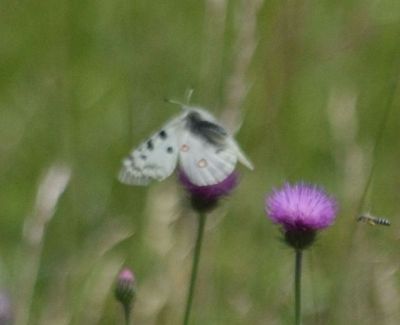
Distant Apollo (record shot)
There were two more stand-out encounters on these slopes. This Blue (below) puzzled me for some time until I found similar pictures on the excellent Butterflies of France web site (see here). So I have identified this sighting as Turquoise Blue for which that resource notes a degree of variation in the under-side between different populations. Today’s individual had delicate pale orange marginal spots with white chevron borders, and was certainly very different from those of the species I had observed in les Cévennes in May 2016.
Il y avait encore deux rencontres extraordinaires sur ces pentes. Cette Azuré (au-dessous) de le perplexe moi pendant un certain temps jusqu’à ce que j’aie trouvé des dessins semblables sur les Papillons excellents de site Internet de la France (voir ici). Donc j’ai identifié cette vue comme l’Azuré du mélilot pour lequel cette ressource note un niveau de variation dans le dessous entre de différentes populations. L’individu d’aujourd’hui avait des taches marginales orange pâle fines avec les frontières de chevron blanches et était très différent certainement de ceux des espèces que j’avais observées dans les Cévennes en mai de 2016.
The 13th and final trip lifer was also at this site. I at first took the largish, chocolate brown number to be a Ringlet of some kind but it is actually Arran Brown. This is another of those historical misnomers involving British place names that date from the 19th century and persist to this day. Other examples are Bath White, Essex and Lulworth Skipper, and in the dragonfly world Norfolk Hawker, all of which are quite inappropriate.
Le voyage 13ème et final “lifer” était aussi sur ce site. J’ai pris au début le nombre marron assez important, au chocolat pour être une Ringlet d’une sorte mais c’est en fait Moiré Fascié. J’étais très content de l’enregistrer pour la première fois ici bien qu’à l’extrémité de l’Ouest de son sud et personne de l’Europe Centrale varient. L’espèce se produit aussi à travers Fennoscandia, en volant de juillet à la fin d’août.
There is no evidence that the butterfly I was now watching (pictured above) has ever occurred on the Scottish Isle of Arran. I was very pleased to record it for the first time here though at the western extremity of its south and central European range. The species also occurs across Fennoscandia, flying from mid-July to late August.
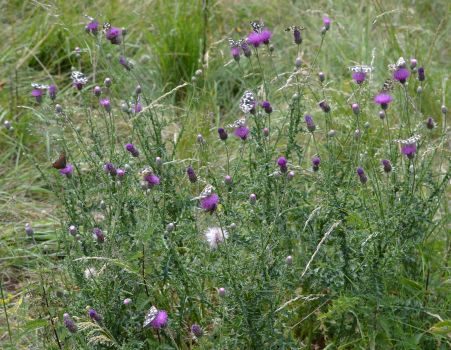
Marbled White colony with guest Arran Brown
I was still having no success in tracking down the Apollo and so returned to Station de Lure to stake out its extensive Thistle resources. There I also descended then climbed back out of the grassy gully that fell away to one side of the car park, still enjoying the above noted energy reserves but encountering nothing new. One Thistle clump (above) in that valley bottom held many Marbled White and there is also another Arran Brown in the picture.
Je n’avais toujours aucun succès dans le fait de retrouver Apollon et ai rendu ainsi au Station de Lure revendiquer ses ressources de Thistle étendues. Là je suis aussi descendu alors a grimpé en arrière du ravin herbeux qui s’est détaché à un côté du parc de stationnement, en appréciant toujours les susdites réserves d’énergie notées, mais en ne rencontrant rien de nouveau. Un bouquet de Thistle (au-dessus) dans ce fond de vallée a tenu beaucoup le Demi-deuil et il y a aussi autre Moiré Fascié dans le dessin.
Lastly, no insect trip report in this journal is complete without a selection of these characters (above). As Cicada sung in their trillions in the trees overhead in some places where I walked, so in others a similar profusion of Grasshopper would escape my footfall. These would often announce themselves by a red flash as they flew that is designed to confuse predators. There was tremendous variety in form, as is normal in southern Europe, and I was impressed again by these insects apparent ability to alter their colouring to blend with the immediate habitat. But one of these four did not appear to have quite mastered the subtle art of camouflage.
Enfin, aucun rapport de voyage d’insecte dans cet journal n’est complet sans une sélection de ces caractères (au-dessus). Comme la Cigale chantée dans leurs trillions dans les arbres au-dessus dans quelques endroits où j’ai marché, donc dans d’autres une profusion semblable de Sauterelle échapperait à mon bruit de pas. Ceux-ci s’annonceraient souvent par un éclat rouge quand ils ont volé qui est conçu pour troubler des prédateurs. Il y avait la variété immense dans la forme, comme est normal dans l’Europe du sud et j’ai été impressionné de nouveau par ces insectes la capacité apparente de changer leur coloration pour me fondre à l’habitat immédiat. Mais un de ces quatre n’avait pas l’air d’avoir tout à fait maîtrisé l’art subtil de camouflage.
Conclusion
This was quite simply a superb trip that produced everything I wanted from a solo expedition in terms of tranquillity, adventure and the sheer joy of self-finding new butterflies. In all I observed 64 different species in this one so scenic part of France, which is of course more than the total number that occur in the whole of the British Isles. The quantity and variety of butterflies to be found here is simply mind boggling. That was not a bad tally for five days considering I was by myself with no specific or prior site knowledge. By comparison the 2014 Greenwings group recorded 108 including 11 more that would have been lifers for me. But those were mostly uncommon, localised species; they had gone to more sites including Mount Ventoux and the butterfly garden at Digne-les-Bains, and they did have Tristan Lafranchis as their guide.
C’était tout simplement un voyage superbe qui a produit tout que j’ai voulu d’une expédition de solo du point de vue de la tranquillité, l’aventure et la joie pure de trouver de soi de nouveaux papillons. En tout j’ai observé 64 différentes espèces dans celui-ci ainsi la partie scénique de la France, qui est évidemment plus que le nombre total qui se produisent dans toutes les Îles britanniques. La quantité et la variété de papillons à être trouvés voici simplement l’esprit s’effrayant. Ce n’était pas un mauvais compte depuis cinq jours en estimant que j’étais moi-même sans connaissance de site spécifique ou préalable. Par comparaison le groupe de Greenwings de 2014 a enregistré 108 en incluant encore 10 qui aurait été “lifers” pour moi. Mais ceux étaient des espèces surtout rares, localisées; ils étaient partis à plus de sites en incluant Mont Ventoux et le jardin de papillon à Digne-les-Bains; et ils avaient Tristan Lafranchis comme leur guide.
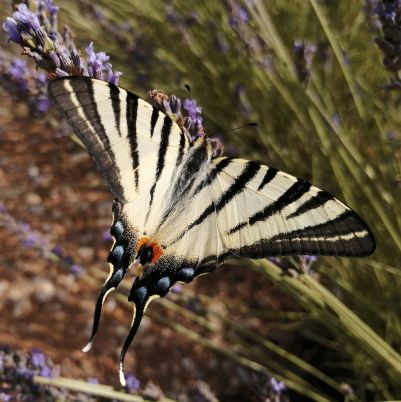
Scarce Swallowtail
My full species list for this trip, with lifers in bold is / Ma pleine liste d’espèces pour ce voyage, avec “lifers” dans l’audacieux est: Swallowtail, Scarce Swallowtail, Apollo, Large White, Small White, Bath White, Berger’s Clouded Yellow, Clouded Yellow f helice, Brimstone, Cleopatra, Eastern Wood White, Ilex Hairstreak, Blue-spot Hairstreak, Small Copper, Sooty Copper, Lang’s Short-tailed Blue, Holly Blue, Large Blue, Baton Blue, Idas Blue, Brown Argus, Chapman’s Blue, Ripart’s Anomalous Blue, Turquoise Blue, Meleager’s Blue, Common Blue, Small Tortoiseshell, Red Admiral, Painted Lady, Queen of Spain Fritillary, Southern Comma, Cardinal, Silver-washed Fritillary, Dark Green Fritillary, High Brown Fritillary, Niobe Fritillary, Marbled Fritillary, Weaver’s Fritillary, False Heath Fritillary, Spotted Fritillary, Meadow Fritillary, Marbled White, Woodland Grayling, Rock Grayling, Grayling, Striped Grayling, The Hermit, Black Satyr, Great Sooty Satyr, Great Banded Grayling, Arran Brown, Meadow Brown, Gatekeeper, Southern Gatekeeper, Small Heath, Dusky Heath, Pearly Heath, Wall Brown, Large Wall Brown, Cinquefoil Skipper, Rosy Grizzled Skipper, Red Underwing Skipper, Marbled Skipper, Lulworth Skipper, Small Skipper = 64

This report has been produced using the free online translator PROMT (see here)
Ce rapport a été produit en utilisant en ligne gratuitement le traducteur PROMT (voir ici)
Species names in French are taken from http://www.leps.it (see here)




























